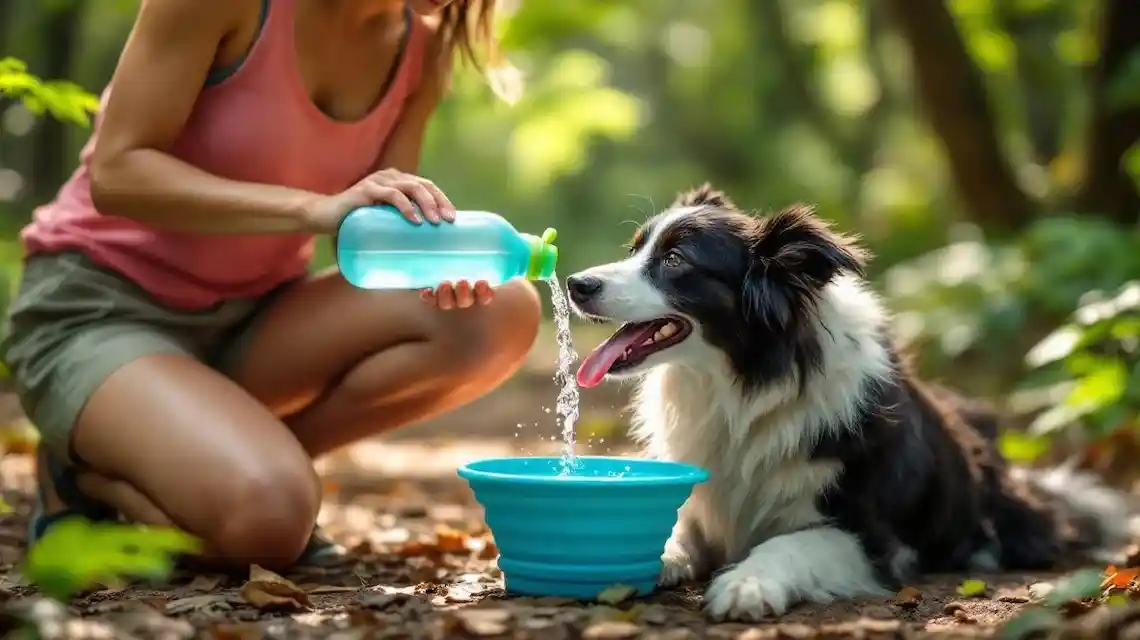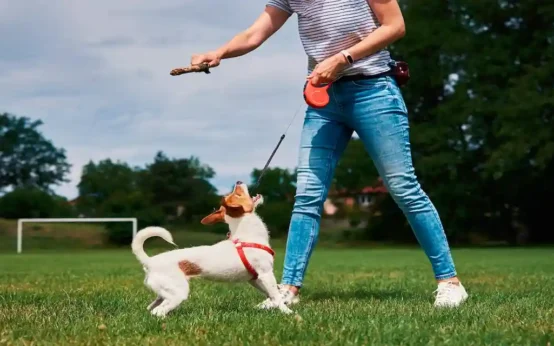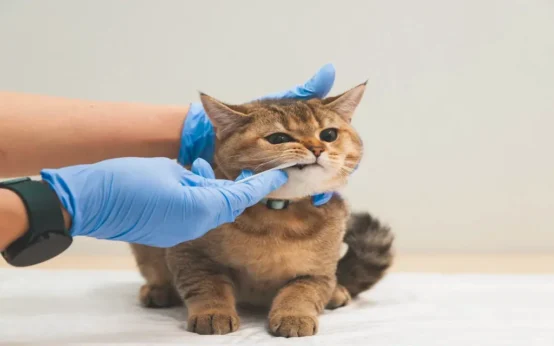Cool evening air feels kind, but it can trick us. We slow down, sweat less, and assume our dogs need less water. In many cases, they need more. City pavement stores heat. Humid air slows cooling. A faster pace or hills raise the load. The fix is simple and steady.
This guide gives you clear water amounts, a carry plan, and easy gear for dark streets. You will also get a step-by-step routine and warning signs to watch for. By the end, you will have a calm plan for keeping dogs hydrated on walks the night without fuss.
Here is what you will learn next: how much water to bring, what gear helps, a simple plan you can follow today, and the signs of trouble to catch fast.
How Much Water Does Your Dog Need for a Night Walk?
Start with a daily baseline. Most dogs need 0.5 to 1 ounce of water per pound of body weight per day. A 20 pound dog needs 10 to 20 ounces across the day. A 60 pound dog needs 30 to 60 ounces across the day. That is your base.
Now add water for the walk itself. Offer 1 to 2 ounces per 10 pounds of body weight every 20 to 30 minutes of steady walking. Small, frequent sips work best. Never force water. Let your dog lick or lap a little, then rest.
Adjust for the real world. Heavy panting, high humidity, warm nights, hills, and long or thick coats all increase need. A brisk city route on fresh asphalt can feel like a mini oven at paw level. Add extra sips and slow the pace when the air feels muggy.
Two quick examples:
- A 20 pound dog on a 40 minute walk needs about 2 to 4 ounces during the walk. Offer 1 ounce at the 15 to 20 minute mark, then 1 to 3 ounces near the end.
- A 60 pound dog on a 60 minute walk needs about 6 to 12 ounces. Offer 2 to 4 ounces every 20 minutes, split into small sips.
Easy carry estimates for a typical 45 minute walk:
- Small dog, carry 8 to 12 ounces.
- Medium dog, carry 16 to 24 ounces.
- Large dog, carry 24 to 32 ounces.
Pre-hydrate before you leave, and rehydrate after you return. Keep it measured and calm. Later sections cover timing and add-ins. You now have solid numbers for keeping dogs hydrated on walks the night without guessing.
Quick water guide by weight, pace, and breed
- Toy and small breeds, offer a mouthful or two every 10 to 15 minutes, a little more if the pace is brisk.
- Medium breeds, 2 to 4 mouthfuls every 10 to 15 minutes, slow down on hills or in heat.
- Large and giant breeds, 3 to 6 mouthfuls every 10 to 15 minutes, more pauses on humid nights.
- Flat-faced breeds and thick coats, offer more frequent sips, shorter walks, and extra shade breaks.
Humidity, heat, and route length change the amount
Dogs cool by panting. On humid nights, panting works less, so their body holds heat. Pavement and brick hold heat after sunset, which raises intake needs. Add 25 percent in high humidity. Add 10 to 20 percent for hills or jogging. If the air feels sticky, slow the pace and add an extra stop.
Pre-hydrate before you leave, without causing bloat
Offer a small drink 60 to 90 minutes before the walk. Then a small sip 10 to 15 minutes before you head out. Avoid big gulps right before or right after hard play. Deep-chested breeds carry a higher bloat risk. Keep sips small, add a short rest before and after drinking, and watch their belly size.
Post-walk rehydration, snacks, and safe add-ins
After you get home, offer measured sips, then more water 20 to 30 minutes later. Add water-rich snacks like thin cucumber slices or soaked kibble. Safe flavor boosts help picky drinkers, like low-sodium bone broth diluted 1 part broth to 3 parts water, or a few ice chips. Skip human sports drinks and any product that lists xylitol.
Night Walk Hydration Gear That Makes Sipping Easy in the Dark
The right gear helps you offer small sips often. It also keeps you visible and safe. Pick tools that fit your routine and your dog’s size.
Collapsible bowls pack flat and open fast at a bench or curb. They are simple and easy to clean. Lick bottles let your dog sip while you move, which helps on busy streets. Hydration vests carry water for long hikes, but only if your dog is fit and healthy.
Add a light and reflective gear for both of you. A small red or amber light near the bowl or bottle helps you track sips in low light. A reflective harness and leash boost visibility from cars and bikes. An insulated bottle keeps water cool and more appealing.
Check lids and seals so you do not soak your bag. Keep the load light. You want your hands free to manage the leash and offer sips. A waist pack or sling makes it easy to carry water, snacks, and a small towel.
Start simple. Try one or two tools for a week, then adjust. Ease matters more than tech. If the gear makes sipping smooth, you will use it.
Collapsible bowl vs lick bottle vs hydration vest
- Collapsible bowl, best for quick stops and bigger gulps, easy to clean, needs two hands.
- Lick bottle, great for steady sips on the move, look for a leak-proof lid, teach your dog to use it at home.
- Hydration vest, use for long hikes only if the fit is snug and the weight is safe, start with light loads and short distances.
Hands-free ways to carry water and stay visible
Use a waist pack, crossbody sling, or clip-on bottle carrier. This frees your hands for the leash and training. Add reflective straps and a small red or amber light near the bowl or bottle. Put a reflective harness on your dog. Always close lids tight to prevent spills.
Broth cubes and dog-safe electrolytes that encourage drinking
Freeze low-sodium broth into cubes and drop one in the bowl. Dilute broth, 1 part broth to 3 parts water. A small splash adds scent and interest. Do not use human sports drinks, and avoid any product with xylitol. If your dog has kidney or heart disease, ask your vet before using broth.
Clean, cool, and safe water on city streets and trails at night
Pack water from home. Do not use puddles or public fountains. These can carry bacteria, oil, or chemicals. Rinse bowls daily. Keep water cool in an insulated bottle. On longer hikes, bring a simple backcountry filter for refills. Offer water in a calm spot away from traffic, bikes, and barking.
A Simple Night-Walk Hydration Plan You Can Follow Today
A routine builds good habits. Keep it short, repeatable, and easy to follow. Use cues and timing so your dog learns to sip on schedule, not only when thirsty.
Sample plan for a 30 minute walk:
- Pre-walk, small drink 60 to 90 minutes before, potty break, then a small sip 10 to 15 minutes before leaving.
- On the walk, stop at minute 10 and minute 20, offer 1 to 3 mouthfuls for small dogs, 2 to 4 for medium, 3 to 5 for large.
- Post-walk, offer a few sips right after you get home, then more water 20 to 30 minutes later.
Sample plan for a 60 minute walk:
- Pre-walk, same as above.
- On the walk, stop every 15 minutes, four short breaks total. Offer 1 to 3 mouthfuls for small dogs, 2 to 4 for medium, 3 to 6 for large. Add one extra stop if the air is humid or the pace is brisk.
- Post-walk, small sips at home, then more water after a short rest.
Keep your carry weight light. Measure the water you bring so you know intake. Pair each break with the same cue and a calm tone.
Pre-walk checklist and timing for water
- Check weather and humidity.
- Pack measured water.
- Bring a collapsible bowl or lick bottle.
- Add a small light to your gear.
- Offer a small drink 60 to 90 minutes before leaving.
- Potty break.
- Offer a small sip 10 to 15 minutes before heading out.
- Skip a full meal right before the walk.
Break schedule: when to stop and how much to offer
Stop every 10 to 15 minutes for 30 to 60 seconds. Offer 1 to 3 mouthfuls for small dogs, 2 to 4 for medium, 3 to 6 for large. If panting is loud or the tongue looks wide and dark, stop sooner and add an extra sip. Then walk again at a calm pace.
Route choices at night that help dogs stay cool and hydrated
Pick shaded or breezy streets, parks with grass, and paths away from heavy traffic and hot pavement. Plan loops that pass a quiet bench or low wall for a calm sip. Skip long hills on warm, humid nights. Slow down on muggy routes and keep breaks short and frequent.
Teach a drink cue so your dog sips on command
Use a simple flow. Say your cue word, like “drink,” as you present the bowl. Mark with a click or a soft “yes” the first moment your dog licks. Praise, then remove the bowl after a few sips. Keep sessions short and calm. Use the cue at every planned break so your dog learns to sip on schedule.
Spot Dehydration at Night and Fix It Fast
Catching early signs in low light is the goal. Move to a calm spot, offer small sips, and cool the body slowly. Most cases improve with rest and measured water. Some need urgent care.
Keep a small light with you. Check gums, tongue color, and energy. Watch how your dog moves and breathes. If anything looks off, stop and reassess. When in doubt, shorten the route and head home.
Early dehydration signs you can spot in low light
Look for sticky gums, thick saliva, a dry nose, sunken or dull eyes, and slow capillary refill over 2 seconds. Press a finger to the gum, then release, color should return in 1 to 2 seconds. Notice lethargy, wobbling, dark or low urine, and fewer pees. Heavy, noisy panting and a wide, dark tongue are red flags. Use a small flashlight to check gums and eyes.
First aid steps and when to call the vet
Move to a cool, quiet spot. Offer small sips every few minutes. Wet the ears, belly, and paws with cool water, not ice cold. Stop the walk and rest. Call a vet if you see vomiting, collapse, confusion, or a temperature over 103 F. If you see heat stroke signs, go to emergency care right away.
Heat stress vs overhydration, key differences
Heat stress, hot body, red gums, rapid pulse, heavy panting, drooling. Overhydration, swollen belly, nausea or vomiting, pale or glazed look, weakness, loss of balance, seizures in severe cases. Prevent both with small, steady sips and planned breaks, not large gulps at once.
Extra care for puppies, seniors, and flat-faced breeds
Puppies and seniors heat up and dehydrate faster. Flat-faced breeds have a harder time cooling. Keep walks shorter, add more breaks, and carry extra water. If your dog has heart, kidney, or breathing issues, talk to your vet and set a personalized water plan before longer night walks.
Conclusion
Night walks feel cool, but needs stay high. Plan your water amounts, pack the right gear, follow a simple break schedule, and watch for early signs. Small, steady sips keep dogs safe and comfortable. With a little prep, you can master keeping dogs hydrated on walks the night without stress. Fill a bottle, grab a bowl, add a light, and enjoy your next evening walk together.
Related post: Dog Snoring in Sleep: What’s Normal, What’s Not
FAQ:
How much water should I bring for a night walk?
Plan about 1 ounce of water per pound of body weight per day. For a 30 to 60 minute walk, pack 0.25 to 0.5 cups per 10 pounds of body weight. Bring extra in warm or humid weather.
How often should my dog drink during the walk?
Offer small sips every 10 to 15 minutes. Do not wait for heavy panting. Take more breaks if the air is warm or your dog is very active.
What are early signs of dehydration I can spot in low light?
Watch for sticky gums, thick ropey saliva, dry nose, sunken eyes, and lethargy. Check gum refill by pressing a finger on the gum. Color should return in under 2 seconds.
Is it safe to give electrolyte drinks?
Use dog-safe electrolyte solutions only, and follow the label. Do not give human sports drinks, they often contain sugar, caffeine, or xylitol. Plain water is fine for most walks.
Can dogs drink too much water at once?
Yes. Large gulps can cause vomiting or, in rare cases, water intoxication. Offer small, frequent sips. Pause play after drinking to avoid bloat, especially in deep-chested breeds.
What temperature should the water be?
Cool or room temperature works best. Very cold water can cause stomach upset in some dogs, especially after hard activity.
What gear helps with hydration at night?
Carry a collapsible bowl or a dog bottle with a built-in cup. Use a hands-free bottle sling. Add a small towel to wipe drool. Clip a light to the bowl so you can see it.
Are certain dogs at higher risk of dehydration?
Yes. Brachycephalic breeds, seniors, puppies, and dogs with kidney, heart, or endocrine disease need closer monitoring. Overweight dogs and heavy-coated breeds heat up faster.
Should I hydrate before leaving the house?
Yes. Offer a modest drink 15 to 20 minutes before the walk. Avoid a full bowl right before strenuous activity to reduce the risk of stomach upset.
What about water after the walk?
Offer small portions every few minutes until thirst eases. Use multiple small servings rather than one large bowl. Check that urine returns to pale yellow within a few hours.
Can I let my dog drink from puddles or streams at night?
Avoid it. Standing water can contain parasites, algae, or chemicals. Carry your own water. If you must refill, use running water from a safe source and a filter rated for protozoa.
Do salty treats or chews affect hydration?
Yes. Salty snacks increase thirst. Keep treats low in sodium on walk nights. Pack moist treats, like soft training bites, to add a little water content.
Is ice a good way to hydrate during a walk?
Small ice chips are fine for cooling and light hydration. Do not rely on ice alone. Pair it with sips of water, and avoid large hard cubes for aggressive chewers.
How does weather at night change hydration needs?
Humid or hot nights raise water needs, even without sun. Windy, cold nights can still dehydrate due to increased respiratory moisture loss. Watch breathing rate and energy.
What if my dog refuses to drink on the walk?
Offer flavored water made by soaking a few kibbles for 2 to 3 minutes. Try a silicone bowl with a wider rim. Stop and rest in a calm spot. Praise for each sip.
Can I use a hydration vest?
Yes, if it fits well and does not trap heat. Keep loads light, usually under 10 percent of body weight. Test at home, then try short walks before longer use.
How do I plan routes for better hydration?
Pick paths with safe lighting and places to stop. Avoid long stretches without shade in warm months. Start and end near your own water source to refill.
What color urine shows good hydration?
Pale yellow is ideal. Dark yellow or orange-tinted urine signals dehydration. If color stays dark after drinking, call your vet.
When should I call a vet about hydration concerns?
Seek help for repeated vomiting, collapse, very dry gums, refusal to drink, or thick saliva with weakness. Also call if your dog has a chronic condition and shows any dehydration signs.
Any tips for dogs on meds?
Diuretics, steroids, and some seizure meds increase thirst. Pack extra water, plan more breaks, and ask your vet about ideal intake for your dog.




 Dog Trick Training for Beginners
Dog Trick Training for Beginners  Gingivitis Cats Symptoms Every Pet Parent Should Know
Gingivitis Cats Symptoms Every Pet Parent Should Know  How to Make Dog Cookies at Home
How to Make Dog Cookies at Home  Wet Food or Dry Food for Cats?
Wet Food or Dry Food for Cats?  What Is the Healthiest Hamster Breed for Your Home?
What Is the Healthiest Hamster Breed for Your Home?  Cat Food Intolerance Symptoms: How To Spot Them Early
Cat Food Intolerance Symptoms: How To Spot Them Early